From Hirokazu Kore-eda’s ワンダフルライフ (Wandâfuru raifu), released in the U.S. in 1998 as Afterlife. This is likely my favorite movie of all time. Dig up a copy at your neighborhood indie video store when you get a chance, it’s good. It’s a simple, quiet parable about life, death, loss, memory, love, and cinema, somewhere between Kurosawa’s Ikiru and Michel Gondry’s Eternal Sunshine.
After whining for years about someone borrowing my out-of-print DVD copy without returning it, I finally looked around and discovered the vastly superior Japanese NTSC Region 2 copy of the movie. ¥3,990 later, I’m now able to enjoy it again as I saw it at the theater in anamorphic widescreen, optional subtitles, and none of the horrible digital low-pass smoothing that someone thought would “fix” the grainy 16mm film’s appearance. Time for a movie screening, I think…



